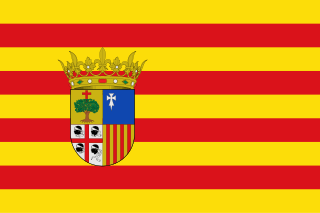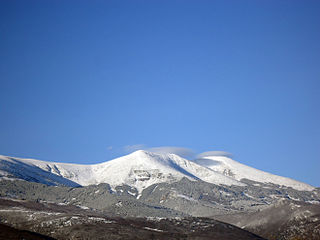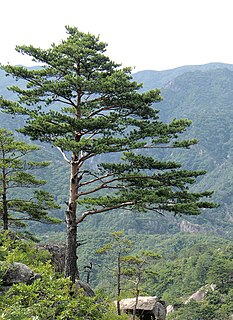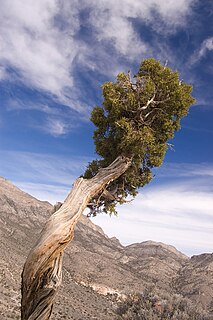
The Sierra Morena is one of the main systems of mountain ranges in Spain. It stretches for 450 kilometres from east to west across the south of the Iberian Peninsula, forming the southern border of the Meseta Central plateau and providing the watershed between the valleys of the Guadiana to the north and the west, and the Guadalquivir to the south.

Soto del Real, whose former name was Chozas de la Sierra, is a town and municipality in the northern area of the autonomous Community of Madrid which had 8,294 inhabitants in 2009.

The Sierra de Guadarrama is a mountain range forming the main eastern section of the Sistema Central, the system of mountain ranges along the centre of the Iberian Peninsula. It is located between the systems Sierra de Gredos in the province of Ávila, and Sierra de Ayllón in the province of Guadalajara.

Sierra de Cazorla is a mountain range of the Prebaetic System in the Jaén Province in Spain. It is named after the town of Cazorla. Its highest point is the 1,847 m high Gilillo peak.

Moncayo is a 15 km long and about 7 km wide mountain massif giving name to the Tarazona y el Moncayo comarca, Aragon, Spain. The Moncayo's highest summit, San Miguel (2,314 m), is the highest point in the 500 km long Sistema Ibérico.
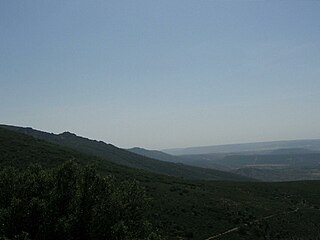
The Montes de Toledo are one of the main systems of mountain ranges in the Iberian Peninsula. They divide the drainage basin of the Tagus from the basin of the Guadiana. The highest peak is 1,603 m high La Villuerca.

Jiloca Comarca is a comarca in Aragon, Spain. It is located in Teruel Province, in the mountainous Iberian System area.
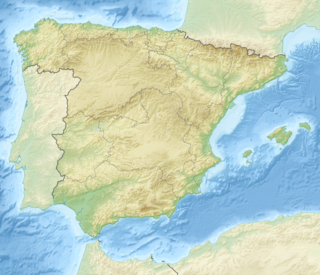
The Sierra Sur de Jaén is a mountain range that is part of the central belt of the Baetic System, Andalusia, Spain. Its name derives from its location in the southwestern part of Jaén Province. The highest summit in the range is 1,872 m high Pico Pandera; 1,722 m high Cerro de la Cruz is another notable peak.

Sierra de Segura is a mountain range of the Prebaetic System in the Jaén Province in Spain. It is named after the ancient town of Segura de la Sierra and it gives its name to the Segura River. Its highest point is the 1,993 m high Las Banderillas peak.

Sierra de Algairén is a mountain range in Aragon, Spain, located between the comarcas of Campo de Cariñena and Comunidad de Calatayud. The ridge's highest summit is Pico de Valdemadera (1,276 m).

Serra de la Valldàngel or Serra de la Vall d'Àngel,, is a mountain range in the Baix Maestrat comarca, Castellón Province, Valencian Community, Spain.

Sierra de Nava Alta or Sierra de la Nava Alta is a mountain range in the Valdejalón comarca, Aragon, Spain, located west of the A-121 road, between Fuendejalón and Ricla and east of Tierga and Mesones de Isuela.

Sierra de la Virgen is a mountain range in the Aranda and Comunidad de Calatayud comarcas, Aragon, Spain. It is located south of the Moncayo Massif between the valleys of the Jalón and the Aranda rivers, rising north of the N-234 road, roughly between Calatayud and Torrelapaja.

Sierra de Caballos or Sierra de los Caballos is a mountain range in the Maestrazgo and Bajo Aragón comarcas of Aragon, Teruel Province, Spain. The highest point in the range is Las Artigas (1,205 m). The Guadalopillo River flows along the northern side of the range.

Sierra de Vicort, also known as Sierra de Vicor, is a 20 km (12 mi) long mountain range in the Comunidad de Calatayud and Campo de Daroca comarcas of Aragon, Spain.

The Solorio Range is a mountain range located in the western side of the Iberian System, Spain. It straddles Aragon, Castile-La Mancha and Castile and León.

The Sierra de Francia is a comarca located at the southern end of Salamanca Province, Castile and León, Spain. It is located about 70 km from Salamanca city. It borders with the Las Hurdes and Las Batuecas comarcas of Extremadura to the south; the Campo Charro to the north and the Sierra de Béjar to the east. The region is sparsely inhabited and its few towns have great cultural value.
